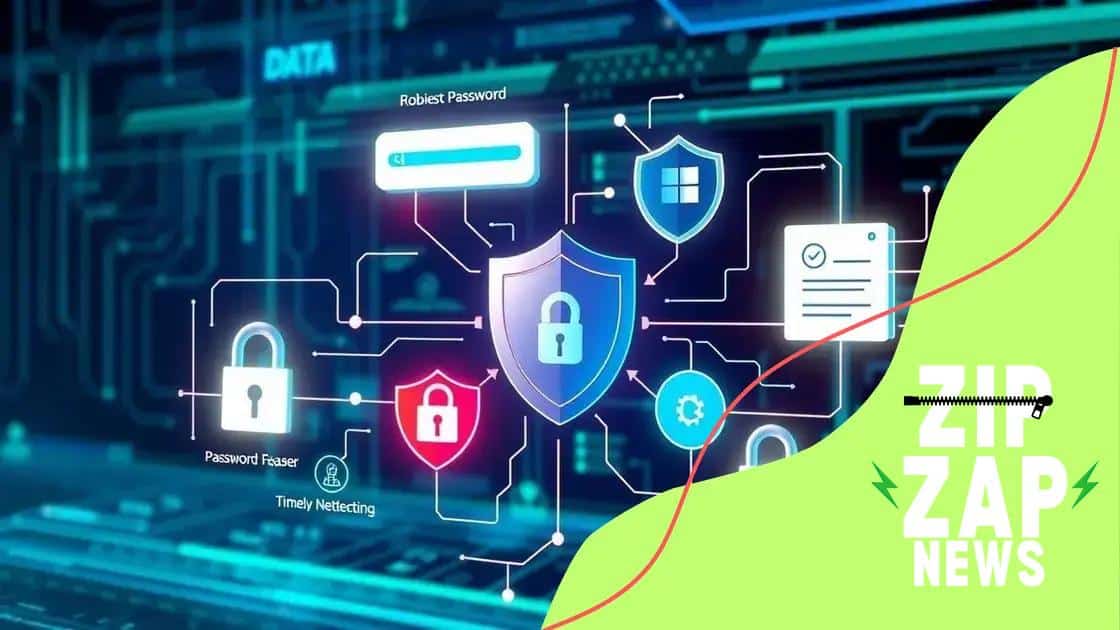Data privacy protections in IoT devices: what you need to know

Data privacy protections in IoT devices involve implementing strong security measures, utilizing AI for threat detection, and adhering to regulations like GDPR and CCPA to safeguard user information.
Data privacy protections in IoT devices are becoming increasingly important as more people connect their lives to the internet. Have you thought about how safe your personal information is in this interconnected world? Let’s dive deeper into this topic.
Understanding IoT and data privacy
Understanding IoT (Internet of Things) and data privacy is crucial as our world becomes more interconnected. Many devices we use daily, from smart TVs to wearable fitness trackers, collect vast amounts of personal data. It’s essential to know how this data is used and protected.
What is IoT?
IoT refers to the network of physical objects embedded with sensors and software that connect to the internet, allowing them to exchange data. This technology can improve efficiency, but it also raises questions about how our data is handled.
Data Privacy Issues with IoT
While IoT devices have many benefits, they can pose risks to our privacy. Many users are unaware of the extent of data collection occurring. It’s vital to understand these risks.
- Devices often collect data without user consent.
- Vulnerabilities in device security can lead to data breaches.
- User data might be sold to third parties.
Given these issues, users should take proactive steps to protect their data. It’s also important that manufacturers prioritize security in their devices.
How to Protect Your Data
To safeguard your privacy, consider these tips:
- Change default passwords on all devices.
- Keep software updated to patch security vulnerabilities.
- Regularly review privacy settings on your devices.
Being proactive can significantly enhance your data security. Knowledge about how IoT devices work and their data practices empowers you to make informed decisions.
Key vulnerabilities in IoT devices
Understanding the key vulnerabilities in IoT devices is essential to protect your data. With these devices becoming commonplace in our lives, awareness of their weaknesses helps enhance our privacy and security.
Common Security Flaws
Many IoT devices suffer from basic security flaws that can be exploited by hackers. These vulnerabilities often stem from poor design and inadequate security measures.
- Weak default passwords that are easy to guess.
- Lack of regular software updates to fix bugs.
- Insecure data transmission methods.
When these devices connect to the internet, they may expose personal information to threats. Recognizing these risks helps users take necessary precautions.
The Role of User Awareness
User awareness plays a critical role in identifying vulnerabilities. By understanding how to secure devices, users can protect their information more effectively. For instance, users should:
- Change default settings immediately.
- Use strong, unique passwords for each device.
- Monitor device activity for unusual behavior.
In addition, reading product reviews and security warnings can give insight into a device’s reliability. As IoT technology advances, so do the techniques used by hackers. Staying informed makes a difference in managing these risks.
Best practices for protecting data

Knowing the best practices for protecting data is vital in today’s world, especially as IoT devices become more prevalent. By implementing specific measures, users can significantly enhance their data security.
Utilizing Strong Passwords
One of the simplest yet most effective ways to protect your data is by using strong passwords. Weak passwords make it easy for hackers to gain access to your devices.
- Combine letters, numbers, and symbols in your passwords.
- Avoid using easily guessed information, like birthdays.
- Change passwords regularly to improve security.
These practices help ensure that your devices remain secure from unauthorized access. Being diligent about your passwords is a foundational step in data protection.
Regular Software Updates
Many users overlook the importance of keeping their device software updated. Manufacturers often release updates that fix security vulnerabilities and improve overall functionality.
- Check for updates regularly and install them promptly.
- Enable automatic updates when possible.
- Be aware of notifications regarding available updates.
Keeping software current protects your devices from known threats, as outdated software can leave you vulnerable.
Understanding Privacy Settings
Another crucial aspect is understanding the privacy settings on your devices. By customizing these settings, you can better control what data is shared.
Regularly review and adjust these settings to match your comfort level with data sharing. It’s important to be proactive rather than reactive regarding your data privacy. Taking these steps ensures a safer environment for your personal information.
Regulations affecting IoT security
Understanding the regulations affecting IoT security is important for both manufacturers and consumers. These regulations help set standards to protect user data and ensure the safe operation of IoT devices.
General Data Protection Regulation (GDPR)
The GDPR is one of the most significant regulations impacting data privacy, especially in the European Union. It requires companies to protect the personal data of users and to be transparent about how they collect and use information.
- Users must give explicit consent for data collection.
- Companies must ensure data security and privacy.
- Fines can be imposed for non-compliance.
This regulation has raised awareness about data protection and influenced how IoT devices operate in the market.
California Consumer Privacy Act (CCPA)
In the United States, the CCPA provides similar protections for consumers in California. It gives users rights over their personal data and requires companies to disclose how they collect, use, and share that data.
- Consumers can opt-out of data sales.
- Businesses must inform users about data collection practices.
- Penalties for not complying can be substantial.
This law empowers consumers to take control of their personal information, affecting how IoT companies design their devices.
Industry Standards
Aside from these laws, industry standards play a crucial role in promoting security in IoT devices. Organizations like the Internet Engineering Task Force (IETF) and the Consumer Technology Association (CTA) set guidelines to enhance device security through best practices.
By adhering to these standards, manufacturers can improve customer trust and ensure their devices meet security expectations. Overall, following regulations and standards is vital to maintain the integrity of users’ data in the IoT landscape.
Future trends in IoT data protection
Future trends in IoT data protection are shaping how we will secure our devices and data. With the rapid advancement of technology, it is essential to stay ahead of emerging threats and practices.
Artificial Intelligence and Machine Learning
One of the most significant trends is the integration of artificial intelligence (AI) and machine learning into IoT security. These technologies can help analyze patterns and detect anomalies in real time, allowing for quicker responses to potential threats.
- AI algorithms can predict potential security breaches.
- Machine learning can adapt to new threats as they evolve.
- Automated security responses can minimize damage from attacks.
As these technologies progress, we can expect enhanced security measures that are proactive rather than just reactive.
Increased Focus on Privacy by Design
Another trend is the emergence of the concept of privacy by design, which means considering data privacy throughout the product development process. This proactive approach ensures that security measures are integrated into devices from the beginning.
Manufacturers will need to prioritize user privacy and meet stringent security standards to build consumer trust. This shift will compel companies to innovate while keeping user safety at the forefront.
Regulatory Changes and Compliance
As concerns about data privacy grow, we can anticipate stricter regulations related to IoT devices. Companies will need to adapt to these regulations to ensure compliance. Regulatory changes may include:
- Stronger penalties for data breaches.
- Mandatory transparency in data collection practices.
- Regular security audits for IoT devices.
Embracing these reforms can help boost consumer confidence and drive innovations in data protection.
In conclusion, protecting data in IoT devices is increasingly important as technology advances. With trends like artificial intelligence, privacy by design, and stricter regulations, there is a clear path toward improving security. By understanding these trends, both consumers and manufacturers can work together to ensure safer devices. Prioritizing data protection helps build trust and fosters innovation, paving the way for a secure future in the IoT landscape.
FAQ – Frequently Asked Questions about IoT Data Protection
What are the main security vulnerabilities in IoT devices?
Common vulnerabilities include weak default passwords, lack of software updates, and insecure data transmissions.
How can AI and machine learning improve IoT security?
AI and machine learning can analyze data patterns to detect anomalies and respond to threats in real time.
What is ‘privacy by design’ in IoT?
‘Privacy by design’ is an approach that integrates data privacy and security measures into the development of IoT products from the start.
Why are regulations important for IoT devices?
Regulations help protect consumer data, ensure transparency, and hold companies accountable for data breaches.





